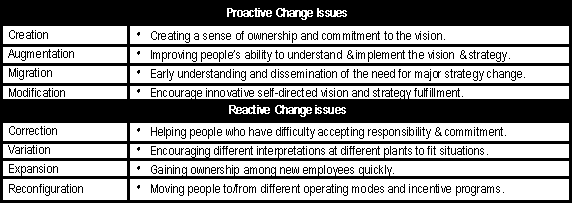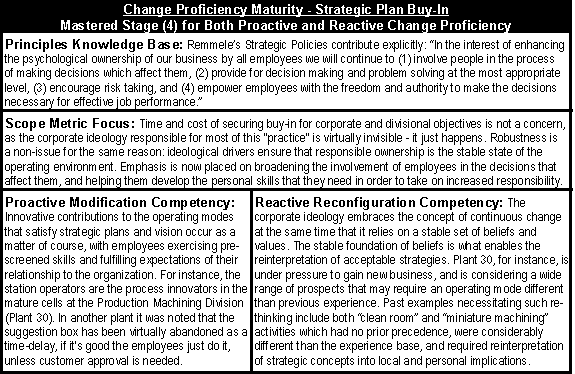Creating a sense of ownership and commitment to the
vision
- The employees display a great sense of pride in the company and an
expectation to function as accountable contributors, exhibiting a strong family identity
and common team spirit. This ideological commitment appears rooted in the corporate
Guiding Principles (see Appendix) and touches everyone with the increasing emphasis on
involving all people in the decisions that affect them. It is clear that management has
not abdicated the responsibility for certain key decisions—like how much will be
allocated for capital—but these decisions are only reached after a great deal
of serious employee input is formally obtained. For instance, periodically a database of
competitive pay scales is developed by looking at other companies and various national
sources. Until the late '80s a management committee would analyze this data and make
general increase recommendations to the president. Now, all employees are given this data
along with a form letter to the president that allows them to make a thoughtful and
knowledgeable recommendation. Experience shows that the majority of people deliver a
well-reasoned number that is considered carefully by the management group. In recent years
the approved increase has been consistently within half a point off the averaged employee
recommendation.
- One manager offered that psychological ownership is powerful and apparent
here and the essence of Remmele's success: "People here are so much in charge of what
they are doing that they can hardly help but feel ownership. People are employed with the
expectation that they will probably be here forever if things work out, and that imposes
on Remmele the need to provide tools that will help them be more valuable to the
organization. This is the management mind-set".
- Commitment and buy-in are also supported by the tools of open information
and rewards tied to company success, discussed in detail elsewhere. "Companies in
which everyone helps make money will outperform companies in which only a few people at
the top see that as their job. In the new economy, creating a company of business people
is the ticket to survival—and prosperity…Open-book management doesn't make
everybody equal. It just assumes that everybody on the payroll has a stake in the
business's success—and that companies work better when people understand that
stake."1
Improving the ability of people to understand and implement the
vision and strategy
- Exemplifying the involvement-in-decisions-that-affect-you point, as well
as showing how the company supports personal knowledge development that enables ownership
and deeper understanding: One division manager recently took four machinists on a world
search for the best high-velocity machining equipment. They shopped heavily in Germany and
France where they spent time talking to customers and users. This involved
- considerable time for each person away from revenue-generating work and
required them to sort through the data and develop a recommendation, which they justified
to other employees as well as to management. These people are now the resident experts on
high-velocity machining and are responsible for integrating the capability into Remmele,
and they own the decision.
Encouraging innovative self-directed vision and strategy fulfillment
- Trust-based relationships are actually alive and well at Remmele and
quite solid because they are practiced universally in all relationships—not just for
the inner circle of management or employees, but also for community, suppliers, and
customers. When asked what was unique about working at Remmele, one shop worker offered:
"We take pride in our work, look at the T-shirt slogans (Pride in Quality
displayed on a few chests), and that’s what we take to heart. We don't like anything
going out the door less than perfect, and we'll talk to the customer about it honestly if
he wants us to ship before we have it the way we want it."
Helping employees that have difficulty with accepting responsibility
and commitment
- When asked what would happen if a new employee gets through the
recruitment screening and turns out to be on the less-engaged or less-prideful side, one
shop worker said: "It wouldn’t happen." Another offered: "We’d
talk to them and help them get up to speed." A third finished with: "Eventually
they’d see that they didn’t fit and leave voluntarily, and if all else failed
the supervisor would invite them to leave."
Encouraging different manifestations at different plants when
situations warrant
- Though the core ideology and corporate strategy establish a foundation,
separate divisions are expected to interpret and implement strategic plans in a context
that suits achievement best in their markets. The Production Machining Division, for
instance, is organized around "focused-factory" cells dedicated to a single
customer's requirement and has evolved a strong cross-functional–team work mode that
accepts responsibility for maintenance, purchasing, recruitment, and other typical support
functions among the cell's operators. Whereas station operation in a cell does not require
the same capabilities that a machinist employs in another plant, it allows time for active
responsibility in a broader set of business support functions. By dispatching these
functions within the cell team, support overhead is minimized and employees gain a broader
set of skills and an understanding of business operation.
Gaining ownership among new employees quickly
- Highly effective information dissemination practices, recruitment
screening for self-motivated people, and an active
help-your-fellow-employee-learn-the-ropes environment bring new employees up to speed
quickly. All employees help the new people learn and practice the company way. Cell teams
in the Production Machining Division, for instance, decide which new team members they
will accept. They help each other come up to speed and take pride in saying that nobody
has failed to fit in as yet.
Moving people freely without impediment from different operating
modes and incentive programs
- Though there are some uncomfortable differences for veteran employees
between the operating modes and skill sets used in the Automation Division (Plant 50), the
Production Machining Division (Plant 30), and the three other machining plants, enough
employees exhibit a willingness to go where the company needs them to satisfy the
mobilization flexibility the company sometimes needs. Even at the apprentice level: one of
the stated differences about Remmele apprentices was their willingness to go where the
company needed them. On the incentive front, everybody participates in corporate profit
sharing, based on total corporate results, with a floor that guarantees 3% of pay minimum
will be contributed to the retirement plan. Anything available above that can be taken as
cash or put into the retirement fund at the employee's discretion. Higher paid top
management has a cap on the amount of profit sharing from this plan. The plan's focus on
corporate results facilitates moving people among plants when appropriate.
|
 Paradigm Shift
Paradigm Shift Paradigm Shift
Paradigm Shift
